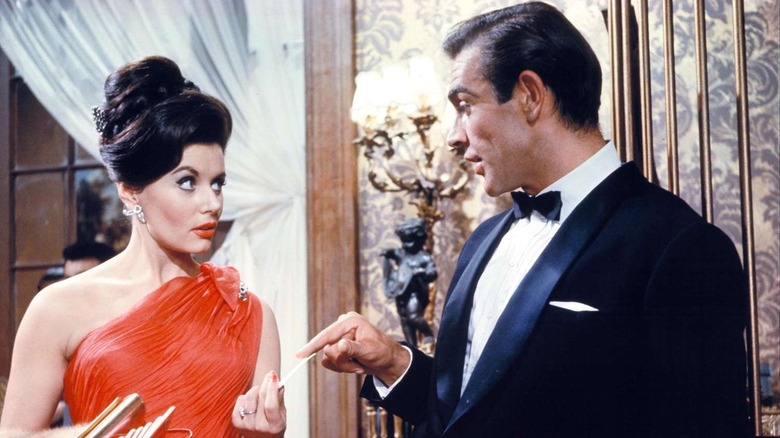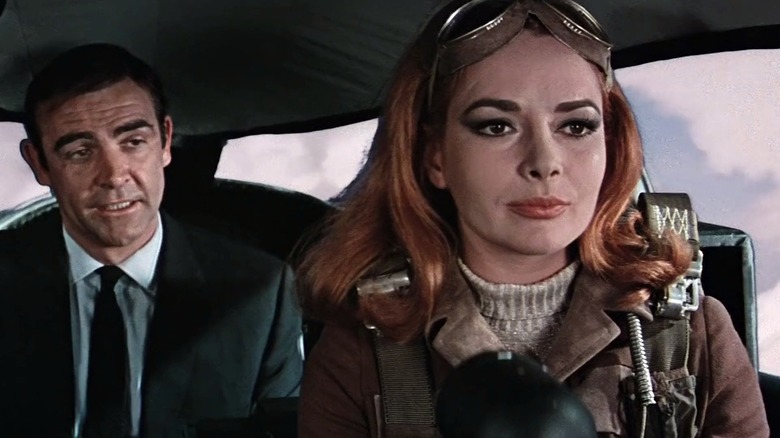Roald Dahl Was Given Three Outdated Rules To Write A Classic James Bond Movie
We may receive a commission on purchases made from links.
When James Bond made his big-screen debut in 1962 with "Dr. No," the world was a decidedly different place than it is now. The United States and the Soviet Union were none-too-quietly waging the Cold War (the Cuban Missile Crisis occurred during 007's first month in theaters), the Civil Rights Movement was challenging systemic racism all over America, and women were fighting for equal pay and control over their own bodies. Perhaps "decidedly" is a touch strong.
As the world grappled with massive political and social upheaval, the movies did what they do best and sent a mess of mixed messages. The industry has always taken seriously its role as a beacon of hope and enlightenment, but, this being a business, filmmakers have never shied away from trafficking in hoary, hurtful stereotypes provided they earned a big enough pop from the audience. In the 1960s, this meant catering directly to the insensitive whims of cis white males. If there was a laugh or a hubba-hubba in the offing, go for it.
When it came to his treatment of women, Sean Connery's James Bond was both a suave cad and an unabashed caveman. He appreciated feminine beauty, but had little time for the person beneath the dazzling surface. Obviously, it was unprofessional, if not fatal, for a spy of 007's stature to fall in love. This is just what his adversaries wanted him to do. Clearly, this fed into his natural distrust of women. But after a while, Connery's brusque treatment of women as Bond became so ingrained in his portrayal that it threatened to play like a Matt Helm parody. According to legendary children's author Roald Dahl, Bond's bad behavior was baked into his character by the producers.
Three simple rules for making James Bond an unrepentant rake
When it came time to write the screenplay for the fifth film in the James Bond series, "You Only Live Twice," Bond producers Harry Saltzman and Albert "Cubby" Broccoli found themselves without the services of Richard Maibaum, who'd penned the first four movies. They turned to Roald Dahl, a friend of the late Ian Fleming who'd operated as a British spy during World War II. The author of "Charlie and the Chocolate Factory" took wild liberties with his pal's strangely self-reflective novel (the follow-up to the superb "On Her Majesty's Secret Service," which is Christopher Nolan's favorite), but when it came to the depiction of the women in the film, he was obliged to obey some very strict rules.
According to Robert A. Caplen's book "Shaken & Stirred: The Feminism of James Bond," Dahl claims he was told by the producers, "You can use three different girls and Bond has them all. No more and no less." It gets more sexist from there.
The first girl, described as "violently pro-Bond," is the sacrificial lamb. She should be killed in Bond's arms, but it must be in good taste (which rules out death by belt sander, I suppose). The second girl is trickier, and, per Dahl, should be treated thusly:
"Girl number two is anti-Bond. She works for the enemy and stays around for the middle third of the picture. She must capture Bond, and Bond must save himself by bowling her over with sheer sexual magnetism. This girl should also be bumped off, preferably in an original fashion."
The third girl is also "violently pro-Bond," but "she must on no account be killed." The producers stressed that she is not to have sex with Bond until the fade-out at the end of the movie (where we typically get a filthy double entendre from our hero).
Dahl was no fan of "You Only Live Twice," and it seems possible that, despite the film's tremendous box office success, the producers had tired of their own formula as well. The next film in the series was "On Her Majesty's Secret Service," which briefly introduced George Lazenby as 007 and featured the great Diana Rigg as the fiercely independent Countess Tracy di Vincenzo. By abandoning their sexist rules for one movie, the filmmakers knocked out what still stands as the best James Bond movie of all time. Alas, it was back to monkey business as usual when Connery returned for the godawful "Diamonds Are Forever."

